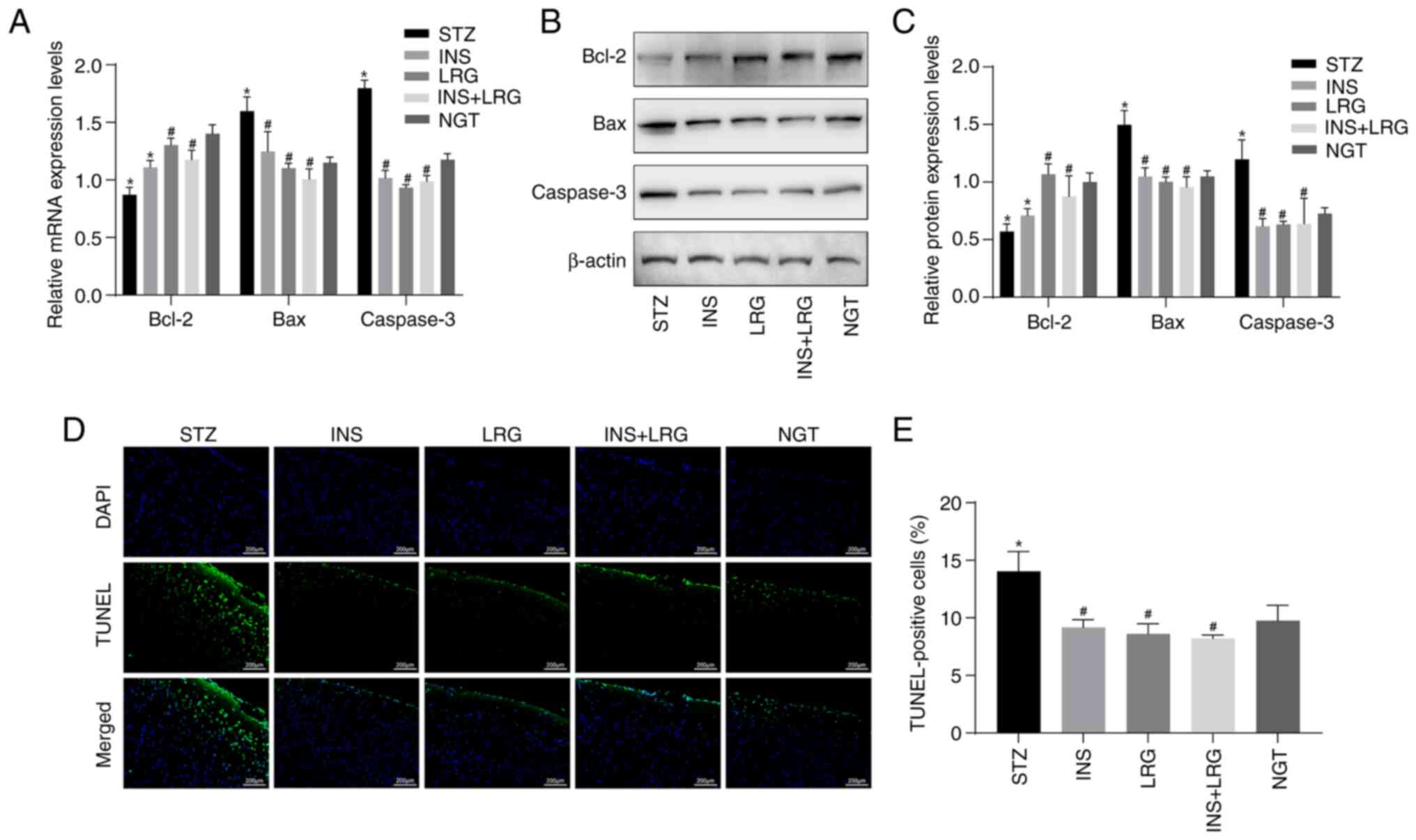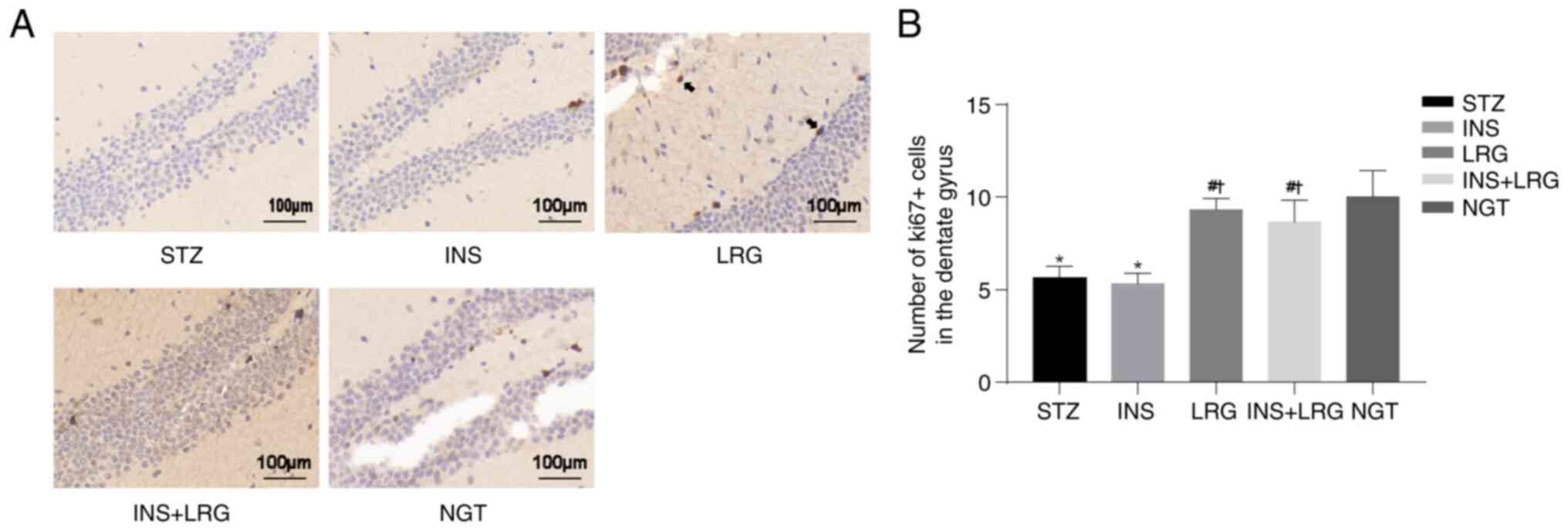|
1
|
Biessels GJ, Staekenborg S, Brunner E,
Brayne C and Scheltens P: Risk of dementia in diabetes mellitus: A
systematic review. Lancet Neurol. 5:64–74. 2006.PubMed/NCBI View Article : Google Scholar
|
|
2
|
Wang C, Lv H, Li Q, Gong K, Yang LL, Wei
Z, Pan Y and Wang M: RNA sequencing of peripheral blood revealed
that the neurotropic TRK receptor signaling pathway shows apparent
correlation in recovery following spinal cord injury at small
cohort. J Mol Neurosci. 68:221–233. 2019.PubMed/NCBI View Article : Google Scholar
|
|
3
|
Marini C, Baldassarre M, Russo T, De
Santis F, Sacco S, Ciancarelli I and Carolei A: Burden of
first-ever ischemic stroke in the oldest old: Evidence from a
population-based study. Neurology. 62:77–81. 2004.PubMed/NCBI View Article : Google Scholar
|
|
4
|
Ho N, Sommers MS and Lucki I: Effects of
diabetes on hippocampal neurogenesis: Links to cognition and
depression. Neurosci Biobehav Rev. 37:1346–1362. 2013.PubMed/NCBI View Article : Google Scholar
|
|
5
|
Salem MA, Budzyńska B, Kowalczyk J, El
Sayed NS and Mansour SM: Tadalafil and bergapten mitigate
streptozotocin-induced sporadic Alzheimer's disease in mice via
modulating neuroinflammation, PI3K/Akt, Wnt/β-catenin, AMPK/mTOR
signaling pathways. Toxicol Appl Pharmacol.
429(115697)2021.PubMed/NCBI View Article : Google Scholar
|
|
6
|
Dubey SK, Lakshmi KK, Krishna KV, Agrawal
M, Singhvi G, Saha RN, Saraf S, Saraf S, Shukla R and Alexander A:
Insulin mediated novel therapies for the treatment of Alzheimer's
disease. Life Sci. 249(117540)2020.PubMed/NCBI View Article : Google Scholar
|
|
7
|
Drucker DJ and Nauck MA: The incretin
system: Glucagon-like peptide-1 receptor agonists and dipeptidyl
peptidase-4 inhibitors in type 2 diabetes. Lancet. 368:1696–1705.
2006.PubMed/NCBI View Article : Google Scholar
|
|
8
|
Lovshin JA and Drucker DJ: Incretin-based
therapies for type 2 diabetes mellitus. Nat Rev Endocrinol.
5:262–269. 2009.PubMed/NCBI View Article : Google Scholar
|
|
9
|
Darsalia V, Nathanson D, Nyström T, Klein
T, Sjöholm Å and Patrone C: GLP-1R activation for the treatment of
stroke: Updating and future perspectives. Rev Endocr Metab Disord.
15:233–242. 2014.PubMed/NCBI View Article : Google Scholar
|
|
10
|
Batista AF, Bodart-Santos V, De Felice FG
and Ferreira ST: Neuroprotective actions of glucagon-like peptide-1
(GLP-1) analogues in Alzheimer's and Parkinson's diseases. CNS
Drugs. 33:209–223. 2019.PubMed/NCBI View Article : Google Scholar
|
|
11
|
Kong FJ, Wu JH, Sun SY, Ma LL and Zhou JQ:
Liraglutide ameliorates cognitive decline by promoting autophagy
via the AMP-activated protein kinase/mammalian target of rapamycin
pathway in a streptozotocin-induced mouse model of diabetes.
Neuropharmacology. 131:316–325. 2018.PubMed/NCBI View Article : Google Scholar
|
|
12
|
Yan W, Pang M, Yu Y, Gou X, Si P,
Zhawatibai A, Zhang Y, Zhang M, Guo T, Yi X and Chen L: The
neuroprotection of liraglutide on diabetic cognitive deficits is
associated with improved hippocampal synapses and inhibited
neuronal apoptosis. Life Sci. 231(116566)2019.PubMed/NCBI View Article : Google Scholar
|
|
13
|
Lee JW, Lee YK, Yuk DY, Choi DY, Ban SB,
Oh KW and Hong JT: Neuro-inflammation induced by lipopolysaccharide
causes cognitive impairment through enhancement of beta-amyloid
generation. J Neuroinflammation. 5(37)2008.PubMed/NCBI View Article : Google Scholar
|
|
14
|
Clevers H and Nusse R: Wnt/β-catenin
signaling and disease. Cell. 149:1192–1205. 2012.PubMed/NCBI View Article : Google Scholar
|
|
15
|
Jia L, Piña-Crespo J and Li Y: Restoring
Wnt/β-catenin signaling is a promising therapeutic strategy for
Alzheimer's disease. Mol Brain. 12(104)2019.PubMed/NCBI View Article : Google Scholar
|
|
16
|
Xu D, Li F, Xue G, Hou K, Fang W and Li Y:
Effect of Wnt signaling pathway on neurogenesis after cerebral
ischemia and its therapeutic potential. Brain Res Bull. 164:1–13.
2020.PubMed/NCBI View Article : Google Scholar
|
|
17
|
Xu Y, Zhang G, Kang Z, Xu Y, Jiang W and
Zhang S: Cornin increases angiogenesis and improves functional
recovery after stroke via the Ang1/Tie2 axis and the Wnt/β-catenin
pathway. Arch Pharm Res. 39:133–142. 2016.PubMed/NCBI View Article : Google Scholar
|
|
18
|
Commission SSaT: Regulations for the
administration of affairs concerning experimental animals. In:
Decree No. 2 of the State Science and Technology Commission China
Legal System Publishing House. State Science and Technology
Commission, China, 2011.
|
|
19
|
National Research Council (US): Committee
for the Update of the Guide for the Care and Use of Laboratory
Animals: The National Academies Collection: Reports funded by
National Institutes of Health. In: Guide for the Care and Use of
Laboratory Animals. 8th edition. National Academies Press (US).
National Academy of Sciences, Washington, DC, 2011.
|
|
20
|
Kilkenny C, Browne W, Cuthill IC, Emerson
M and Altman DG: National Centre for the Replacement, Refinement
and Reduction of Amimals in Research. Animal research: Reporting in
vivo experiments-the ARRIVE guidelines. J Cereb Blood Flow Metab.
31:991–993. 2011.PubMed/NCBI View Article : Google Scholar
|
|
21
|
Livak KJ and Schmittgen TD: Analysis of
relative gene expression data using real-time quantitative PCR and
the 2(-Delta Delta C(T)) method. Methods. 25:402–408.
2001.PubMed/NCBI View Article : Google Scholar
|
|
22
|
Yu J, Shi YC, Ping F, Li W, Zhang HB, He
SL, Zhao Y, Xu LL and Li YX: Liraglutide inhibits
osteoclastogenesis and improves bone loss by downregulating Trem2
in female type 1 diabetic mice: Findings from transcriptomics.
Front Endocrinol (Lausanne). 12(763646)2021.PubMed/NCBI View Article : Google Scholar
|
|
23
|
Shalimova A, Graff B, Gąsecki D, Wolf J,
Sabisz A, Szurowska E, Jodzio K and Narkiewicz K: Cognitive
dysfunction in type 1 diabetes mellitus. J Clin Endocrinol Metab.
104:2239–2249. 2019.PubMed/NCBI View Article : Google Scholar
|
|
24
|
Cameron FJ, Northam EA and Ryan CM: The
effect of type 1 diabetes on the developing brain. Lancet Child
Adolesc Health. 3:427–436. 2019.PubMed/NCBI View Article : Google Scholar
|
|
25
|
Perkins BA, Lovblom LE, Lanctôt SO, Lamb K
and Cherney DZI: Discoveries from the study of longstanding type 1
diabetes. Diabetologia. 64:1189–1200. 2021.PubMed/NCBI View Article : Google Scholar
|
|
26
|
Darwish MA, Abo-Youssef AM, Messiha BAS,
Abo-Saif AA and Abdel-Bakky MS: Resveratrol inhibits macrophage
infiltration of pancreatic islets in streptozotocin-induced type 1
diabetic mice via attenuation of the CXCL16/NF-κΒ p65 signaling
pathway. Life Sci. 272(119250)2021.PubMed/NCBI View Article : Google Scholar
|
|
27
|
Madrakhimov SB, Yang JY, Kim JH, Han JW
and Park TK: mTOR-dependent dysregulation of autophagy contributes
to the retinal ganglion cell loss in streptozotocin-induced
diabetic retinopathy. Cell Commun Signal. 19(29)2021.PubMed/NCBI View Article : Google Scholar
|
|
28
|
Palleria C, Leo A, Andreozzi F, Citraro R,
Iannone M, Spiga R, Sesti G, Constanti A, De Sarro G, Arturi F and
Russo E: Liraglutide prevents cognitive decline in a rat model of
streptozotocin-induced diabetes independently from its peripheral
metabolic effects. Behav Brain Res. 321:157–169. 2017.PubMed/NCBI View Article : Google Scholar
|
|
29
|
Hölscher C: The incretin hormones
glucagonlike peptide 1 and glucose-dependent insulinotropic
polypeptide are neuroprotective in mouse models of Alzheimer's
disease. Alzheimers Dement. 10 (Suppl 1):S47–S54. 2014.PubMed/NCBI View Article : Google Scholar
|
|
30
|
Barman J, Kumar R, Saha G, Tiwari K and
Dubey VK: Apoptosis: Mediator molecules, interplay with other cell
death processes and therapeutic potentials. Curr Pharm Biotechnol.
19:644–663. 2018.PubMed/NCBI View Article : Google Scholar
|
|
31
|
Singh R, Letai A and Sarosiek K:
Regulation of apoptosis in health and disease: The balancing act of
BCL-2 family proteins. Nat Rev Mol Cell Biol. 20:175–193.
2019.PubMed/NCBI View Article : Google Scholar
|
|
32
|
Pratchayasakul W, Thongnak LO,
Chattipakorn K, Lungaphin A, Pongchaidecha A, Satjaritanun P,
Jaiwongkam T, Kerdphoo S and Chattipakorn SC: Atorvastatin and
insulin equally mitigate brain pathology in diabetic rats. Toxicol
Appl Pharmacol. 342:79–85. 2018.PubMed/NCBI View Article : Google Scholar
|
|
33
|
Malekiyan R, Abdanipour A, Sohrabi D and
Jafari Anarkooli I: Antioxidant and neuroprotective effects of
lycopene and insulin in the hippocampus of streptozotocin-induced
diabetic rats. Biomed Rep. 10:47–54. 2019.PubMed/NCBI View Article : Google Scholar
|
|
34
|
Irfannuddin I, Sarahdeaz SFP, Murti K,
Santoso B and Koibuchi N: The effect of ketogenic diets on
neurogenesis and apoptosis in the dentate gyrus of the male rat
hippocampus. J Physiol Sci. 71(3)2021.PubMed/NCBI View Article : Google Scholar
|
|
35
|
El-Akabawy G and El-Kholy W:
Neuroprotective effect of ginger in the brain of
streptozotocin-induced diabetic rats. Ann Anat. 196:119–128.
2014.PubMed/NCBI View Article : Google Scholar
|
|
36
|
ALmohaimeed HM, Mohammedsaleh ZM, Batawi
AH, Balgoon MJ, Ramadan OI, Baz HA, Al Jaouni S and Ayuob NN:
Synergistic anti-inflammatory and neuroprotective effects of
cinnamomum cassia and zingiber officinale alleviate
diabetes-induced hippocampal changes in male albino rats:
Structural and molecular evidence. Front Cell Dev Biol.
9(727049)2021.PubMed/NCBI View Article : Google Scholar
|
|
37
|
Haas CB, Kalinine E, Zimmer ER, Hansel G,
Brochier AW, Oses JP, Portela LV and Muller AP: Brain insulin
administration triggers distinct cognitive and neurotrophic
responses in young and aged rats. Mol Neurobiol. 53:5807–5817.
2016.PubMed/NCBI View Article : Google Scholar
|
|
38
|
Fares J, Bou Diab Z, Nabha S and Fares Y:
Neurogenesis in the adult hippocampus: History, regulation, and
prospective roles. Int J Neurosci. 129:598–611. 2019.PubMed/NCBI View Article : Google Scholar
|
|
39
|
Foulquier S, Daskalopoulos EP, Lluri G,
Hermans KCM, Deb A and Blankesteijn WM: WNT signaling in cardiac
and vascular disease. Pharmacol Rev. 70:68–141. 2018.PubMed/NCBI View Article : Google Scholar
|
|
40
|
Kim DY, Jung SY, Kim K and Kim CJ:
Treadmill exercise ameliorates Alzheimer disease-associated memory
loss through the Wnt signaling pathway in the
streptozotocin-induced diabetic rats. J Exerc Rehabil. 12:276–283.
2016.PubMed/NCBI View Article : Google Scholar
|
|
41
|
Xu D, Hou K, Li F, Chen S, Fang W and Li
Y: XQ-1H alleviates cerebral ischemia in mice through inhibition of
apoptosis and promotion of neurogenesis in a Wnt/β-catenin
signaling dependent way. Life Sci. 235(116844)2019.PubMed/NCBI View Article : Google Scholar
|
|
42
|
Zhao C, Liang J, Yang Y, Yu M and Qu X:
The impact of glucagon-like peptide-1 on bone metabolism and its
possible mechanisms. Front Endocrinol (Lausanne).
8(98)2017.PubMed/NCBI View Article : Google Scholar
|
|
43
|
Palsgaard J, Emanuelli B, Winnay JN,
Sumara G, Karsenty G and Kahn CR: Cross-talk between insulin and
Wnt signaling in preadipocytes: Role of Wnt co-receptor low density
lipoprotein receptor-related protein-5 (LRP5). J Biol Chem.
287:12016–12026. 2012.PubMed/NCBI View Article : Google Scholar
|
|
44
|
Yang S, Zhang Y, Zhang Z, Dan J, Zhou Q,
Wang X, Li W, Zhou L, Yang L and Xie L: Insulin promotes corneal
nerve repair and wound healing in type 1 diabetic mice by enhancing
Wnt/β-catenin signaling. Am J Pathol. 190:2237–2250.
2020.PubMed/NCBI View Article : Google Scholar
|
|
45
|
Doble BW and Woodgett JR: GSK-3: Tricks of
the trade for a multi-tasking kinase. J Cell Sci. 116:1175–1186.
2003.PubMed/NCBI View Article : Google Scholar
|
|
46
|
He W, Tian X, Lv M and Wang H: Liraglutide
protects neurite outgrowth of cortical neurons under oxidative
stress though activating the Wnt pathway. J Stroke Cerebrovasc Dis.
27:2696–2702. 2018.PubMed/NCBI View Article : Google Scholar
|















